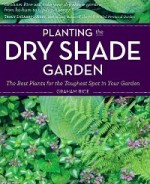 As any gardener knows, a dry shady area is the most difficult site to grow plants. The lack of both light and moisture combine to inhibit plant growth and produce an area that is often grim and unattractive. Many gardeners abandon such areas and make them into storage areas. This does not have to be true and Graham Rice’s book, Planting the Dry Shade Garden, shows you how to deal with the problems and select plants that can grow successfully.
As any gardener knows, a dry shady area is the most difficult site to grow plants. The lack of both light and moisture combine to inhibit plant growth and produce an area that is often grim and unattractive. Many gardeners abandon such areas and make them into storage areas. This does not have to be true and Graham Rice’s book, Planting the Dry Shade Garden, shows you how to deal with the problems and select plants that can grow successfully.
Key to planting in the shade is understanding the nature of the problem and Rice begins by analyzing different kinds of shade and moisture issues. He provides lists of trees by the amount of shade or drought they produce so you can plan ahead when developing a landscape plan. Next, the author suggests ways to reduce the shade created by trees and increase moisture levels.
The largest part of the book is devoted to selecting plants for the dry shade garden. The author notes that the best strategy when selecting plants is choosing plants that have adapted to dry shade in their natural habitats. Be forewarned; these are not the floriferous plants that grow in a sunny border. They are different and can be used to create a feast for the eye in a dry, shady area. By pursuing the plants adapted to dry shade, gardeners can find a whole new world of attractive plants that start their life cycle early so they can produce flowers before the trees leaf out in spring, have colorful berries, or have beautiful foliage that adds color and texture throughout the growing season. The author presents over 160 plants arranged in alphabetical order by type: shrubs, climbers, perennials, ground covers, bulbs, annuals and biennials. Each entry is accompanied by a description, suggestions for use in the garden, a full color photograph, and recommended selections. When you go to buy boxwood, for example, you will have descriptions of seven cultivars to guide you in your choice.
If you have an area of dry shade this is an excellent book to help you make it into an attractive garden. The beauty of the plants is brought out by the numerous photos and serve to inspire and encourage the reader to tackle to the problem of dry shade. Written in a friendly conversational style and organized in a simple way with a clear format, the book is easy to use and fun to peruse.